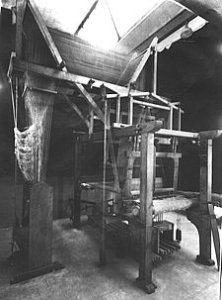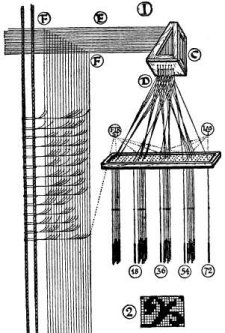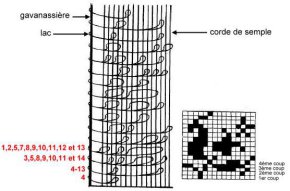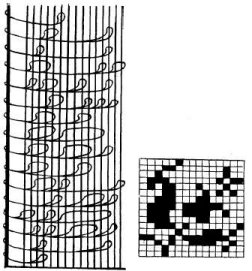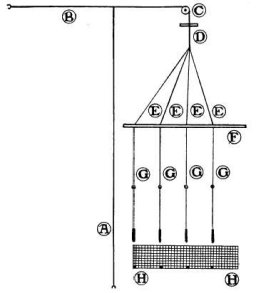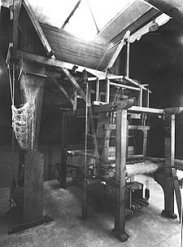- Home
- Resurrection ▾
-
Learn ▾
- Free library
- Glossary
- Documents
- Initiation
-
Shaped fabrics
- Introduction
- Popularization
- Definitions
- Le métier de façonné
- Principes du façonné
- Mécaniques de façonné
- Le jeu des crochets
- Les cartons
- Chaîne des cartons
- Mécanique 104 en détail
- Pour en finir
- Montage façonné
- Empoutage 1/3
- Empoutage 2/3
- Empoutage 3/3
- Punching, hanging and dip
- Autres façonnés
- Façonnés et Islam
-
Cours de tissage 1912
- Bâti d'un métier
- Le rouleau arrière
- Les bascules
- Formation du pas
- Position de organes
- Mécanique 104 Jacquard
- Fonctionnement 104
- Lisage des cartons
- Le battant du métier
- Le régulateur
- Réduction et régulateur
- Mise au métier d'une chaîne
- Mise en route du métier
- Navettes à soie
- Battage
- Ourdissage mécanique
- Préparation chaînes et trames
- Equipment ▾
- Chronicles ▾
- Fabrics ▾
- Techniques ▾
- Culture ▾
- Language ▾
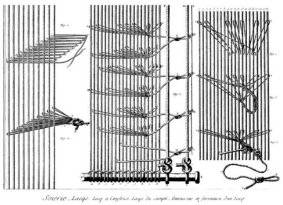
Silk, development of cords and simple and their action on the threads of the warp threads of brocaded fabrics or the pile of uncut and cut velvets, plate No. 62 of the facsimile collection of the 127 plates relating to silk and weaving, encyclopaedia , Diderot and d'Alembert, 18th c.
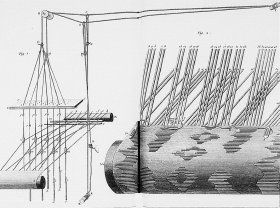
The draw-loom "à la grande tire" like the one of Philippe De Lasalle which was the most successful with its independent and interchangable simple which made it possible to realize motifs of greater extent in height by replacing several simples one after the other, possessed 2400 cords instead of of 800.
We have described here the operation of the draw-loom. There is of course, in addition, a classic system of lifting (harness), composed of shaft frames which allows to make the bottom in satin or other, and controlled by means of pedals (or steps).
Now that we have fully understood the principle of draw-loom, here is a new sketch representing the whole system.
Let us take again our sketch, and observe the lake (horizontal lash) from the bottom. It imprisons the fourth simple cord which will lift the fourth warp thread of each pattern, as is verified on the first shuttle stroke of the fabric (horizontal line at the bottom of the pattern). Continue by observing the second lash. It traps the simple cords 4 and 13, and we check indeed on the second shuttle stroke that it is indeed the threads 4 and 13 which raise, then 3, 5, 8, 9, 10, 11 and 14 on the third shot 1, 2, 5, 7, 8, 9, 10, 11, 12 and 13 on the fourth shot, and so on. All the horizontal strings (lashes) are tied in order on a large cord, so the draw boy will only have to pull the lashes one after the other in this predefined order, so that the pattern is formed gradually over the weaving.
In the previous figure, for the sake of clarity, a single string A was used, controlling the 4 threads G, the first threads of each path of the fabric H. Here we see on the right the pattern composed of 15 threads and on the left we see the 15 vertical cords required to control these 15 threads of the pattern. Referring to the foregoing sketch, it will be understood that each of the 15 strings will be connected to 4 warp threads. Until then everything is clear ...
We can count 15 warp threads and 16 weft threads making up our pattern on the right sketch. On the left one, we can count 15 simple cords corresponding to the 15 warp threads, and also 16 lashes (horizontal strings looping on one or more cords) corresponding to the 16 wefts.
The basic sketch of the draw-loom is this one. The fabric is shown in H. It is seen that for the sake of clarity only the first thread of each of the four paths is represented (the pattern is repeated 4 times over the width of the fabric). These 4 threads do exactly the same job. They will be lifted together and therefore the corresponding 4 heddles (G) are attached in D to the same simple cord B which passes over a pulley C. A simple cord A is connected to the cord B for allowing the draw boy to pull on this cord B. It is therefore perfectly clear that if one pulls on the cord A, the first thread of the 4 patterns will rise.
Principle of the draw-loom for the use of the neophyte.
Before the invention of Jacquard mechanics, at the beginning of the XIXth century, the fabrics were made on draw-looms. If many popular books refer to it, few describe it to the neophyte, not to say none in the French language ...
We will therefore remedy this deficiency by referring to the sketches of the excellent English author Luther Hooper, taken from two of his books: "Silk, its production and manufacture", and "The new draw-loom" , Published in London in 1932.
